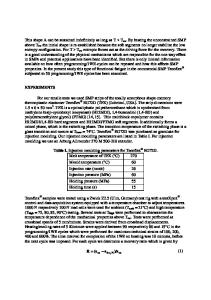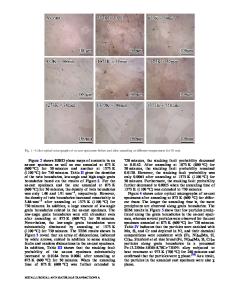Thermomechanics of the Shape Memory Effect in Polymers
- PDF / 180,172 Bytes
- 6 Pages / 612 x 792 pts (letter) Page_size
- 97 Downloads / 366 Views
W5.8.1
Thermomechanics of the Shape Memory Effect in Polymers Yiping Liu, Ken Gall, Martin L Dunn, Alan R Greenberg Department of Mechanical Engineering University of Colorado, Boulder, CO 80309, U.S.A. ABSTRACT Shape memory polymers (SMPs) have the capacity to store and recover relatively large strains when subjected to a unique thermomechanical cycle. In this study, the thermomechanics of strain storage and strain/stress recovery are investigated in a shape memory polymer deformed under uniaxial tension and compression. During heated recovery, three cases of constraint are examined: unconstrained (free) strain recovery, stress recovery under pre-strain constraint, and stress recovery under fixed-strain constraint. Based on the experimental results, a onedimensional SMP constitutive model is developed, which is motivated by the shape memory mechanism of the polymer network. The foundation of the model is that the entropy change is gradually stored during cooling and released during reheating as free recovery strain or constrained recovery stress. When fit to free strain recovery data, the model can predict the trends of the stress evolution during shape fixation and constrained strain/stress recovery under various thermomechanical conditions. INTRODUCTION Shape memory materials are defined by their capacity to store a deformed (temporary) shape and recover an original (parent) shape, which are typically induced by a change in temperature. Shape memory polymers should have a cross-linked network structure, which permits a rubbery plateau at temperatures above the glass transition temperature Tg [1]. The properties of a polymer near Tg account for the shape memory behavior during a thermomechanical cycle. At temperatures well below Tg, the polymer is in the glassy state and the low temperature elasticity is due to primary molecular interaction. At temperatures well above Tg, the polymer is in the rubbery state. The deformation energy is converted into conformational entropy changes [2,3]. If the entropy state induced by the high temperature deformation is cooled to low temperatures, then it can be stored “temporarily” or “frozen” by emerging atomic interactions. The frozen entropy can only be released when strong molecular interaction has disappeared after subsequent heating to a high temperature. Recently, substantial research efforts on shape memory polymers are emerging on the areas of biomedical devices, deployable space structures and nano/micro systems [4-6]. The design of shape memory polymer based devices demands thorough characterization and constitutive modeling of the shape memory cycle [7,8]. In this study we adopt the concept of “frozen” entropy into a simplified thermomechanical model and illustrate the efficiency of the model by comparing the experimental and constitutive modeling results for an epoxy resin, which is a thermoset network polymer. MATERIALS AND EXPERIMENTAL METHODS Test specimens were prepared from a commercial amorphous thermoset epoxy system, which is intended for deployable composite
Data Loading...











